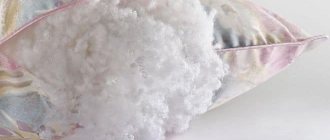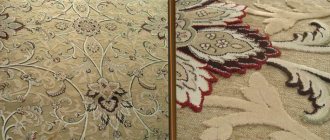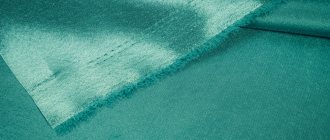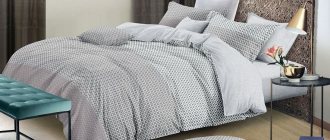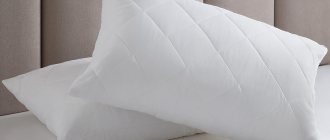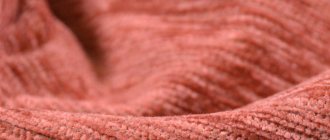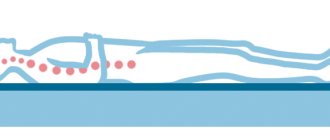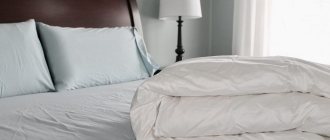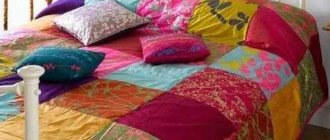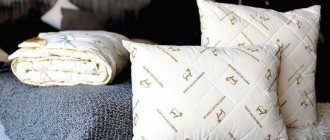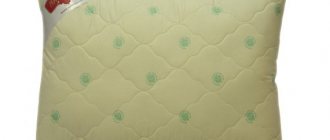In the world of modern technology, nothing is impossible. Humanity has learned to create high-quality analogues of natural leather and animal fur, bird feathers and down. The properties of artificial materials are not inferior to natural ones, and sometimes they are superior in quality and hypoallergenicity. We looked at all the pros and cons of artificial swan down, whether it is harmful to the body, and compared it with a popular filler.
What is artificial swan down?
Artificial swan down is a synthetic material consisting of polyester fibers twisted in a spiral and secured together with silicone polymer. These include: holofiber, Thinsulate, padding polyester. Visually, artificial down is no different from natural down. The structure of chemical fiber is more fluffy and soft, and easily returns to its original shape after compression or creasing. Some manufacturers of sleep and rest products call swan filler synthetic down or Thinsulate.
Advantages and disadvantages
A swan's down blanket has its pros and cons. The chemically produced material has a whole range of attractive properties. Advantages:
- hypoallergenic, eliminates dust allergies. Suitable for children and allergy sufferers, people with sensitive problem skin;
- prevents the reproduction of living organisms (dust mites, fungi, mold);
- has no odor, does not absorb foreign aggressive aromas;
- Resistant to rapid wear during operation. The fluff does not roll up or bunch up;
- maintains thermoregulation on par with natural analogues;
- Light, fluffy, elastic material holds the shape of the product throughout the entire period of use. Does not wrinkle, does not require constant shaking, quickly takes on the desired shape;
- does not require special care, can be washed in a washing machine on a gentle cycle, dries quickly. Can be stored in a closed closet, cabinet, chest of drawers. Does without ventilation;
- The cost of a product made with artificial fibers is significantly lower than that made with natural fibers.
Flaws:
- capable of electrifying and sparkling. Without special antistatic treatment, it accumulates small doses of static electricity;
- low level of hygroscopicity. Not suitable for people who sweat profusely;
- does not allow air to pass through well and causes overheating of the body. In hot climates, it is better not to use an artificial down blanket in the summer.
Differences from natural
Natural swan down tends to clump and absorb aromas; it is heavier and can only be hand washed or dry cleaned. Gets dirty quickly and requires regular shaking and airing.
A blanket made of artificial swan down is a complete replacement for a product filled with natural fibers, easy to use and care for, and does not require special storage conditions.
User reviews
Buyers who use products filled with artificial down confirm the excellent properties of the material. This is evidenced by the growing demand for the entire range.
Artificial down is successfully used in warm jackets, blankets, bedspreads, and pillows. Reviews about it say that this material is much warmer and more practical than padding polyester. Those people who used it instead of real fluff due to an allergic reaction note that the new material combines all the unique properties. This allows the product to reliably retain heat and dry quickly. Moreover, products with artificial down are very light.
It is very easy to wash products with synthetic down. They feel great in an automatic car. The rules are the usual: fasten the buttons and zippers and wash, first turning them inside out. Maximum temperature – 30 degrees. If all conditions are met, the product can be washed many times. The appearance and quality of the filler do not deteriorate.
Varieties of swan down blankets
Manufacturers produce swan blankets of various thicknesses and densities. It depends on the season for which the product is intended and the category of consumers.
All-season, summer, winter
Blankets for any season are a versatile year-round option. Microfiber has been added to the material; it retains heat well in cool weather and provides comfortable rest in the summer. Natural cotton fabrics, satin, and poplin are used as covers. They have an average down density of 200-300 g/m2.
Summer models are thin, contain a minimum of swan filling, and are intended for people with impaired body thermoregulation. The density of the down is lightweight and does not exceed 150-180 g/m2.
The winter version has a high density of down, significant thickness, retains elasticity, lightness, and volume. Textiles for winter models - linen, poplin, cotton. Density exceeds 350-400 g/m2.
When choosing a thing, you need to focus not only on size, but also on density indicators.
Children's, adults
The swan's down blanket is available for children and adults. A child sleeps comfortably under such a blanket. The product is light and weightless and can be washed frequently. Children's swan blankets have an average thickness and different sizes, depending on the age and height of the baby.
For adults, there are standard sizes and different thicknesses, depending on seasonality.
To reduce costs, you can purchase an all-season version of the blanket.
Tips for choosing
When choosing a pillow, pay attention to the manufacturer. A company with a long history produces a quality product, this is the only way to stay in business for more than 10 years. Small fly-by-night companies offer goods cheaper, but of lower quality.
Almost all pillow models are made in different sizes. Before purchasing, decide which one suits your bed best. When describing the model, its height and rigidity are indicated. These are important indicators that need to be taken into account.
Standard sizes of swan down blankets
Sleep products are divided by size, which is determined by generally accepted standards.
Single
A single bedspread is designed for one person. Often this option is purchased for a child. Standard size 140x140 cm or 110x140 cm. Suitable for a single bed.
One-and-a-half-sleeper
The product is designed for a one-and-a-half bed that can accommodate two people. Dimensions 150x205 cm or 140x205 cm.
Double
The bedspread for a double bed is designed for a family, the width and length are 175x205 cm.
Euro
Largest blanket size. According to the standard 200x220 cm. There are other Euro size options - 200x200 cm, 200x215 cm.
We recommend reading: - Choosing a blanket for sleeping - how to determine the size and choose the filling.
Advantages
The main advantage, oddly enough, is the completely synthetic origin of the material. It is wear-resistant, retains heat well, but does not contribute to overheating of the body. It does not cake and does not form those very lumps that are characteristic of natural fluff. Weightless, soft, very elastic.
Additional benefits:
Which filler is better: bamboo or swan down?
Bamboo filling and swan down have similar properties. During operation, these materials manifest themselves in different ways. The main disadvantage of bamboo is its weight, which is heavier compared to down. The cost of a bamboo blanket is higher than that of a swan blanket. Down warms well. Bamboo ensures complete air circulation and prevents the body from overheating. Unlike a down bedspread, a bamboo bedspread absorbs moisture well and dries very quickly. The general advantages of the materials include the ability to not attract dust, retain their shape for a long time, and are easy to maintain.
Bio-down protects heat and animals.
Bio-fluff appeared in the 70s, thanks to one unfortunate technological mistake that was made during the production of biopolymers. However, the owners were not at a loss and very far-sightedly adopted the new development, immediately patenting it (“DuPont” and “Sorona”). The future Bio-fluff was improved and began to be used by two world-famous companies: DuPont and Thinsulate. By the way, the latter is in the production of a very thin but warm material “Thinsulate”, which has long won the hearts of everyone who lives in northern latitudes (including mine!). What I mean is that this is a kind of guarantee of a quality mark from a company that knows in practice what a truly warm synthetic material is) . Bio-fluff immediately carried out successful tests, going to the North Pole in the clothes of polar explorers. To this day, this eco-insulation material is widely used in the production of winter clothing and equipment (for example, sleeping bags).
In general, Bio-down is very similar in appearance to holofiber, only it is less dense, which means it is more airy, light and heat-intensive. And in terms of its properties, it is most similar to Thinsulate, only it is not in the form of layers, but in the form of small elastic balls. In essence, this is Thinsulate, only more advanced, in balls.
The production of this synthetic material is based on plant raw materials, from which, through chemical processing, environmentally friendly insulation . In this regard, Bio-down can be compared to viscose, which is called rayon (it is extracted from wood and then processed in a factory to obtain thin, durable threads). It’s interesting that Bio-down also contains a little bit of wool, considering that during the manufacturing process, the polymer fiber is twisted into spirals (this is how wool behaves in bad weather), and then coated with silicone (like sheep fat, lanolin, coats each wool). We can say that Bio-down in appearance and properties is very, very similar to natural material!
|
|
And no one will pluck the poor birds. Of course, we are told that fluff is collected during natural molting, but we know the laws of business, which dictate that we squeeze out everything possible to the maximum. From one adult individual you can collect only about 40 grams of raw materials, and the story with the unfortunate Angora rabbits repeats itself, only this time on swans. Let's love animals for real and stop this disgrace, especially since the alternative is so perfect)
And what’s also important is that the production of Bio-fluff consumes a third less electricity than, say, the production of nylon, and 2/3 less greenhouse gases are released into the atmosphere. For this, the manufacturer received a prestigious award from environmentalists for the achievements of “green” chemistry.
Famous manufacturers
The most famous manufacturers of sleep and leisure products are constantly improving their products. They offer new models, materials for the case, stylish options for stitching and finishing. These manufacturers actively use artificial swan down for their products, these include well-known brands:
Ecotex (Ecotex)
A domestic company that produces home textiles. The products are distinguished by the quality of materials and tailoring, style and sense of proportion in design.
Artpostel
Ivanovo factory for the production of items for home, sleep and recreation. Products can be purchased directly from the factory or through the store. Quality, comfort, price – the calling card of the manufacturer.
Kariguz
European brand. Produces down and feather fillings. The certificate complies with international quality standards.
Vasilisa
Manufacturer from Ivanovo, leader in the Russian textile market. High-quality, stylish, fashionable products are sold in Russia and Europe.
Verossa (Verossa)
Well-known trade brand. Produces premium swan down blankets. Light, airy items with good thermal insulation are in demand among buyers.
Safety level of synthetic fur
Synthetic fluff is absolutely safe and suitable for almost everyone: the material does not cause allergic reactions.
In addition to being hypoallergenic, it has another quality that is important for human health - it does not collect dust. The structure and properties of the fibers do not allow dust to accumulate, so conditions favorable for dust mites do not arise.
Important! Using items with synthetic down filling will not cause complications in patients with bronchial asthma and other pulmonary diseases.
Features of caring for swan duvets
Items with artificial swan down do not require maintenance. You must follow the operating instructions:
- periodically ventilate and shake the item. The filler and cover will be freed from excess dust, the artificial material will gain access to air into the fibers;
- You can remove dirt by hand or in the washing machine. When washing, add antistatic rinse aid. Dry cleaning is acceptable;
- shake the item after washing to evenly distribute the filler around the perimeter;
- Dry in a place with fresh air circulation. Outdoors.
The advantages of artificial swan down extend the life of the item, easy care, comfort during sleep and rest. Take care of your sleep, be healthy!
How much synthetic fluff do you need for a pillow?
Pillows filled with polyester down are suitable for both children and adults, but for people with allergies they are simply irreplaceable. You can buy such a product in a store or make it yourself - you just need to calculate how much synthetic fluff you need for a pillow.
Nonwoven fabric can have different densities, the unit of measurement of which is decitex (dtex). To make an elastic and soft pillow, a not too dense filler (1-1.5 dtex) is suitable.
Manufacturers claim that a 70x70 cm pillow will require 0.9 kg of down, and a 70x50 cm pillow will require 0.6 kg. The cost of a handmade product is half the price of a purchased one.
Flaws
However, while listing the advantages, we should not forget about the disadvantages of synthetics. This fluff is non-hygroscopic. If a person sweats a lot during sleep, bedding with the described filler will not suit him. The fact is that the material copes well with a small amount of moisture, but if there is a lot of it, a “sauna effect” occurs. The person will simply feel uncomfortable: hot, humid, unpleasant.
The second disadvantage is possible overheating. Synthetic down provides good air exchange and maintains a comfortable microclimate in rooms with an optimal temperature. If the room is hot, it stops coping with the task. Then there is a possibility of overheating.
The third disadvantage is the accumulation of static electricity. But almost all synthetic materials have this drawback. Artificial down can crack, stick to the body and even give you an electric shock, which is not very pleasant. Therefore, it is recommended to treat underwear or clothes with synthetic filling with antistatic agents.
